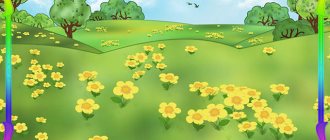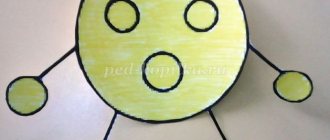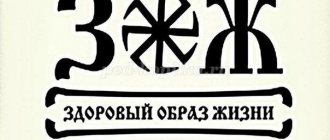Basic techniques for working with children 4–5 years old
A teacher can use a wide range of tools in methodological work.
Visual techniques (sample, display)
The teacher's demonstration is accompanied by the active actions of the children themselves, which helps to achieve effective assimilation and consolidation of new material. Children perform simple mathematical operations, pronouncing their actions in chorus. These include:
- determination of the number of many objects;
- determining their length;
- elementary account.
Mastering new intellectual skills (comparing objects according to any attribute, counting) requires a full, thorough, consistent demonstration with detailed verbal instructions and examination of a sample. As children learn new concepts, expressions and words, demonstration is replaced by oral action.
Photo gallery: visual aids in mathematics for children 4–5 years old
Video: DIY educational games
Verbal techniques
Verbal techniques, such as directions, explanations, and questions stimulate children's active attention and help them remember new terms and lexical expressions. Explanations must be clear, concise and understandable for children . During the children’s answers, the teacher shows patience, does not interrupt, listens to the end, tries not to answer for the child, and, if necessary, asks additional questions that help the child cope with the task independently.
The psycho-intellectual feature of children of the fifth year of life is their desire for sensory-motor exploration of the world around them. The teacher puzzles the kids with problems, solving which the children can feel like little scientists and discoverers, for example, trying to understand why a bicycle has round wheels and not square. The teacher tries to lead the children to an independent answer with the help of leading questions and hints: “Trace the square with your finger. What does this figure have that the circle doesn’t? Why can't a square roll? . Intellectual insight will help you experience a feeling of satisfaction and bring joy from the process of learning about the world.
It is important to note that students in the middle group must be given cognitive tasks from the first lessons in order to develop natural curiosity and an inquisitive mind. The knowledge acquired through self-examination will become valuable experience, and new words and concepts will be perceived more consciously.
Video: cognitive tasks and outdoor games in mathematics class
Game Techniques: Education and Fun
The teacher uses in pedagogical practice elements of games of a search and competitive nature with a variable variety of exercises and tasks according to the level of complexity. Involving characters and fairy-tale plots will also help. “Weeding the beds” together with the rabbit in search of carrots (and counting the remaining amount of weeds) is much more interesting for a child than solving mathematical examples outside the game context.
Table: card index of didactic games for ordinal counting and simple arithmetic calculations
Video: game tasks in mathematics in the middle group
Motivating start to class
For learning to be effective, children must be properly set up for work and interested in the process. For this purpose, preschool pedagogy has a whole range of measures.
Playing out the scenario and thematic nature of the lesson
A keen interest in completing complex tasks and exercises will help awaken the teacher’s creativity. To activate the attention of your pupils, you can use in your work a popular fairy-tale or literary plot beloved by children, interesting visual aids, mathematical poems, riddles, counting rhymes, etc. The appearance of a fairy-tale hero will create a situation that will involve children in a game or invite them on a fantastic journey.
- “A fairy tale is calling us to visit” - the teacher, together with the children, invites the Russian folk tale “Teremok”. The magic house will open the door only to those who solve all the riddles and solve all the problems.
- “Masha saves her brother” - the activity is built around the plot of the popular folk tale “Geese and Swans”. The teacher tells the story of a naughty girl Masha, who, against her parents’ wishes, ran away into the forest with her friends and left her brother alone at home. Masha was so carried away by picking berries and mushrooms that she lost calls to the house. The teacher asks the children to help choose the correct key of a certain geometric shape that will open the door. Once in the house, Masha discovers that Vanechka was carried away by evil birds to Baba Yaga. Now the guys need to overcome the trials and save their little brother.
Examples of questions for an introductory conversation (children look at pictures):
- Did you recognize the fairy tale?
- How many trees are there around Teremok?
- How many windows are there in the house?
- How many mushrooms and berries did Masha collect?
- How many girls are there in the clearing?
- How many girls were left when Masha ran home?
Educational films and video clips
Short videos and animated films on the topic being studied can also be useful in the work of a teacher, since they are an easy way to attract the child’s attention. However, you should not overuse them; it is recommended to use no more than 2-3 videos per lesson.
Video: educational cartoon about numbers “Counting with Paula” (number 5)
Topics for educators on self-education in mathematics
- Formation in children of middle preschool age of primary ideas about the properties and relationships of objects in the surrounding world through didactic games with mathematical content. (It's about shape, color, size, quantity, number, etc.)
- Development of mathematical concepts in children using Cuisenaire rods and Dienes blocks.
- Formation of elementary mathematical concepts of preschoolers in the process of various types of activities.
- Using ICT in mathematics classes in the middle group.
Familiarity with the most important logical operations, the formation of an elementary level of mathematical concepts, the study of the abstract concept of number, the ability to determine the qualitative characteristics of objects and systematize them according to certain properties is a significant condition for the high-quality intellectual preparation of children for school life. By developing and educating their little charges, educators understand that the future successful development of mathematical knowledge and the intellectual culture of children as a whole depends on how successful and productive their pedagogical efforts are.
Goals and objectives of the formation of elementary mathematical representations (FEMP)
Learning mathematics is an integral part of the educational process. The rapid development of science and technology in a large number of industries - from the construction of buildings to space exploration - requires relevant knowledge from a modern person. Therefore, the child takes his first steps in this direction in kindergarten. A couple more abbreviations worth remembering are GED, direct educational activity, and OED, organized educational activity. The formation of mathematical concepts also correlates with them.
The general educational significance of a mathematics course, like any other subject, lies primarily in the general concepts that it gives and which expand a person’s horizons and ways of approaching the phenomena of life. From this point of view, mathematics is important, firstly, for its logic, consistency and accuracy of conclusions. Secondly, the good thing about math is that it is difficult. Her abstract, rigorous reasoning requires great and lengthy mental effort, requiring not so much memory as understanding and consideration.
Goals of the formation of elementary mathematical representations (FEMP):
- children’s development of an understanding of quantitative relationships between objects;
- mastery of specific techniques in the cognitive sphere (analysis, synthesis, comparison, systematization, generalization);
- stimulating the development of independent and non-standard thinking, which will contribute to the development of intellectual culture as a whole.
Objectives for the development of mathematical skills for secondary group students:
- learning numbers, learning ordinal counting within five;
- training in comparison operations using conditional measures, constructing ordered series according to any criterion;
- familiarization with geometric shapes: rectangle and square; cylinder, sphere and cube; cone and cylinder, oval and circle;
- developing the ability to separate shape from other features of an object;
- improving the skills of movement and rotation of the body in the indicated direction, orientation in two-dimensional space (forward-backward; up-down; left-right);
- development of temporal concepts: sequences of annual seasons and parts of the day;
- mastering special terminology that allows you to pronounce the properties of objects.
Children learn quantitative calculations in a playful way and study numbers.





